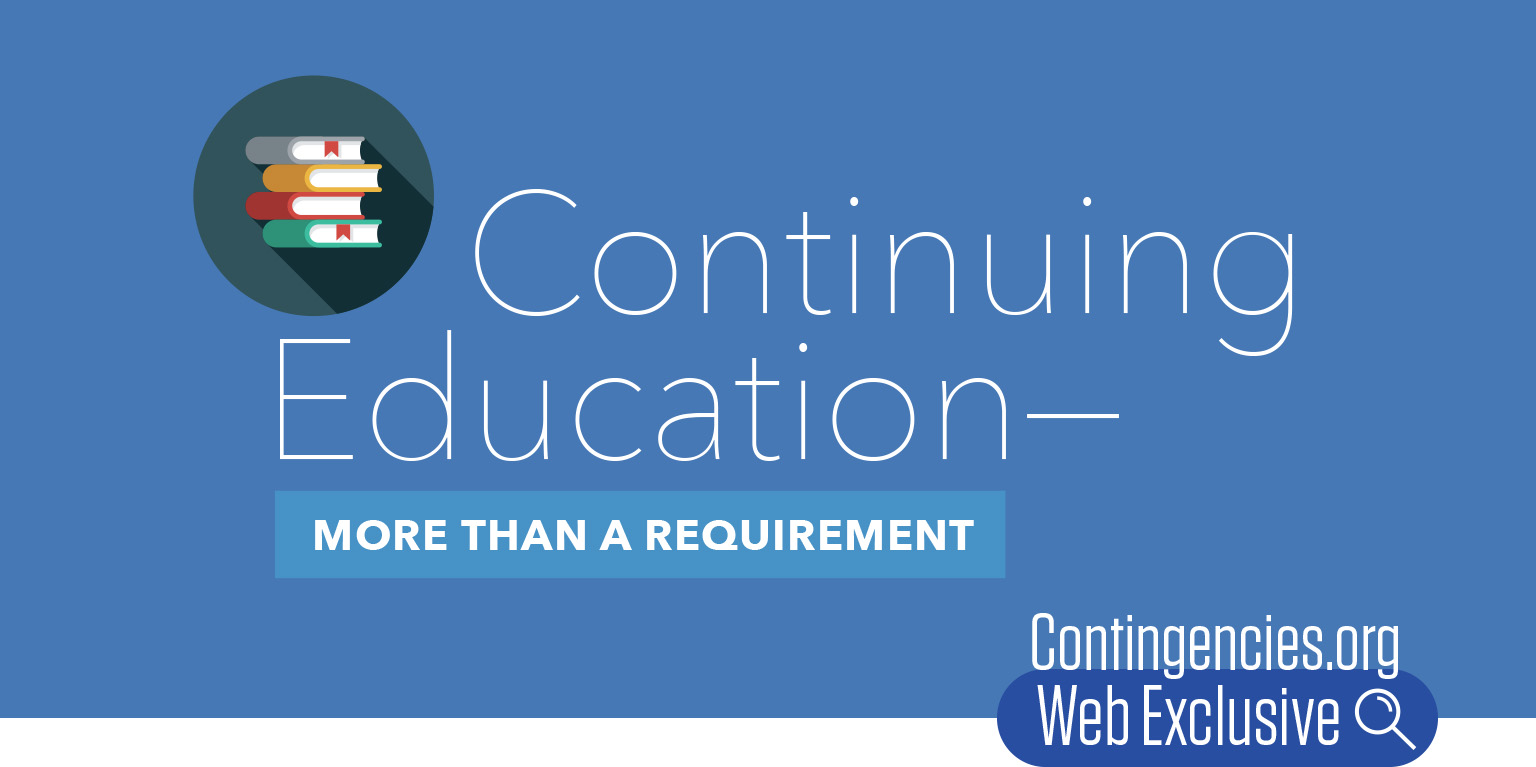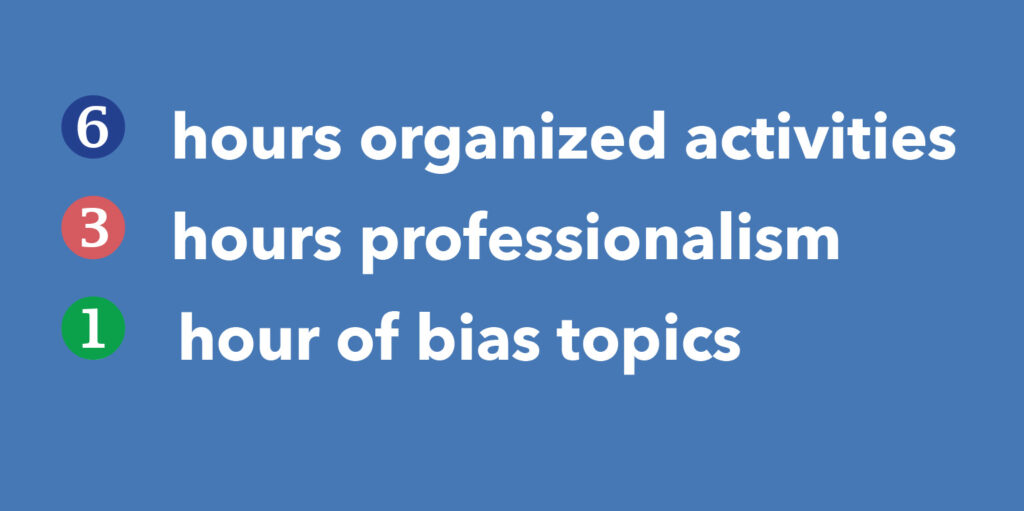
Maintaining continuing education (CE) is essential for compliance-but it’s also a powerful tool for career development, professional credibility, enhanced value for employers and stakeholders, and advancing the actuarial profession. Find out how the Academy’s CE offerings help you stay current, connected, and prepared for what’s next.

By Nancy Behrens and Al Bingham
Continuing Education (CE) is an important and necessary part of every actuary’s development over the course of an entire actuarial career. It begins immediately after, and sometimes, even before basic education is complete. Under the Qualification Standards for actuaries issuing Statements of Actuarial Opinion in the United States (U.S. Qualification Standards or USQS), CE is required for all actuaries signing any Statements of Actuarial Opinion (SAOs) in the U.S.
This article will explore the ways that CE can enhance your reputation, expand your actuarial network, and have a positive impact on your career. CE is also vitally important for our profession as it continues to build its reputation and maintain self-regulation.

What Does the USQS Require?
The U.S. Qualification Standards requires that an actuary complete at least 30 CE hours each calendar year. Of these 30 CE hours, at least six must be through an organized activity (education involving interaction with actuaries and other professionals working for different organizations), at least three hours must cover professionalism topics, and at least one hour must cover bias topics.
In some areas of practice, 30 hours may be sufficient to keep abreast of changes. However, if you have experienced a situation where a new regulation has become effective, or where you have rotated to a new area, you will likely need more hours to become competent to issue SAOs.

If you have been working for more than a few years, you already know that the actuarial field is constantly evolving. The skills that actuaries must possess to provide useful and professional SAOs, and relevant actuarial analyses change frequently. It is essential that actuaries keep up with the changes in their specific areas of practice. Some examples of these changing requirements are:
- Emerging practices and technologies
- New regulations and legislation
- Changing markets
- New products
- Models and modeling techniques (including artificial intelligence)
- Emerging data analytics technology
The public has every right to expect that actuaries, as professionals, are providing SAOs only when they are doing so in a manner that reflects the current requirements of regulations and actuarial practice. Maintaining your CE may also help to avoid running afoul of the disciplinary process and perhaps legal problems. CE helps keep the practicing actuary in compliance with the Code of Professional Conduct and the USQS and is a significant part of “doing your job well.”

Finally, it is worth noting that other professionals also have CE requirements, including doctors, lawyers and accountants, some of whom face even more rigorous requirements than actuaries.
Additional Benefits
Beyond just satisfying the USQS requirements, CE has several benefits. For example:
- Completing additional continuing education can better prepare you to take on a future position or type of project.
- Expanding your actuarial network through seminars or while providing comments on articles can be a valuable byproduct of completing your CE. Networks are important because they allow access to trusted people for advice and may also lead to future employment prospects and/or volunteer opportunities.
- Failing to stay informed can lead to flawed analyses and poor work, which can significantly harm your reputation, your business, and the profession. It can also lead to professional discipline and perhaps legal problems.
- Supporting self-regulation of the actuarial profession by making sure that actuaries are, and are viewed as, both competent and current is a key function of CE.
- Reinforcing the public image of actuaries as trusted professionals is another outcome of CE.
- Maintaining CE helps build cross-disciplinary knowledge.
The Academy’s Role
Since its founding in 1965, the Academy has recognized that the continued professional development of our members and those who aspire to become members is vital. Let’s explore some ways the Academy enables that.
The Academy Learning online portal, accessible through your member login, helps every actuary grow professionally and meet the CE requirements of USQS.

Academy members can track their earned continuing education credits, whether earned through Academy programming and publications or through other organizations, in Academy Learning. The software used previously by Academy members, TRACE, is being retired and is currently only available to review historical data. Any new credits earned, either through Academy webinars and seminars or with another organization, can be maintained in Academy Learning under the “My Learning” tab.
The Academy sponsors/co-sponsors in-person CE events throughout the year. You can browse the Academy’s event calendar to find webinars and other events that fit into your professional development plan. As an example, if you are signing specific statements of actuarial opinion, you should consider attending the Life and Health Qualifications Seminar or the Seminar on Effective P/C Loss Reserve Opinions. These are signature Academy events for those who are signing such opinions and for actuaries whose work helps support those actuarial opinions. It also aligns well with the USQS requirements.
In Academy Learning, webinars are organized by practice area and feature cross-practice, policy-related, and professionalism topics. Watching a live webinar typically counts toward your organized activity requirement of six hours. Recorded webinars are free to Academy members, which is a great benefit of membership. While recorded webinars do not count toward organized activity, they still allow you to hear the presenters, as well as the audience questions, and can be counted toward your overall annual CE requirement.

Reading papers is also an excellent way of keeping up to date in your practice area. From practice notes and issue briefs on very specific topics to Contingencies articles on more general topics, the Academy provides a wealth of information and resources for its members and the U.S. actuarial profession.
Because of the Academy’s leading role in supporting professionalism of U.S. actuaries, you will find fundamental professionalism standards and resources on the Academy’s website: the Code of Professional Conduct, the Actuarial Standards of Practice, the Applicability Guidelines, and the U.S. Qualification Standards. Discussion papers from the Committee on Professional Responsibility are available in the resources section. The topics of these papers range from “Actuarial Professionalism Considerations for Generative AI” to “Conflicts of Interest when Doing Volunteer Work.”

Professionalism webinars that can be found in the Academy Learning catalog include the ever-popular Tales From the Dark Side presented by Actuarial Board for Counseling and Discipline members who discuss cases studies inspired by cases that have come before the ABCD and how to avoid becoming the subject of a future case. Professionalism Counts includes short articles that are a quick read on topics of interest. Up to Code is a column that appears in Contingencies where ABCD members address timely topics.
In addition, the Academy’s essential role as the leading voice on public policy issues for the U.S. actuarial profession is well represented on the Academy’s newly revamped website, actuary.org and within Academy Learning. Actuaries will find sections dedicated to practice area content, as well as specific policy and practice issues. The search functionality enables users to search by topic, format, and more. The Academy develops and delivers over 300 publications annually, from practice notes, comment letters and our Actuarially Sound blogs to research studies and issue briefs, all of which are made available to Academy members and stakeholders for critical knowledge development and needed CE.
Some notable webinars on policy and practice-related topics include the annual updates on the Social Security and Medicare Trustee Reports, post-NAIC meeting recaps, and deep dives on topics such as artificial intelligence (AI) and algorithmic bias, climate change, cyber security risk, aging and retirement security, and more.

Making CE Meaningful
At least once a year, take time to review any new requirements that will become effective in your area of practice. These may be new regulations, a new Actuarial Standard of Practice (ASOP), or other developments. You should also think about emerging areas or skills that can help you develop your expertise. By planning for the knowledge that you will need to acquire, you will be able to look for the best available applicable resources to help you. Completing CE should not just be a box that you check each year. It should reflect your real professional growth.

Invest in Your Growth
By now, we hope that you are intrigued enough to look up a few of the resources mentioned above. There is an abundance of CE resources available to Academy members. While CE is a requirement for those signing SAOs, it is much more than meeting your 30 hours. It is, in fact, an opportunity and investment in your career that serves both you and the profession. By remaining open to new ideas, and being willing to invest in your future, you will support the profession and prepare yourself for new opportunities.
We encourage you to dive into some of the resources mentioned above. It will be good for you, our profession, our employers, and the many stakeholders we serve and engage with as actuaries.
Nancy Behrens became the Academy’s vice president, professionalism and education, in November 2024. She previously served for six years on the Actuarial Board for Counseling and Discipline, and on the Academy’s Committee on Professional Responsibility and other professionalism committees.
Al Bingham is a former Academy vice president of both health and professionalism, serving in the former role during passage of the Affordable Care Act in 2010. He received the Jarvis Farley Service Award in 2024-a lifetime achievement award that honors a member whose volunteer efforts on behalf of the Academy have made significant contributions to the advancement of the profession.